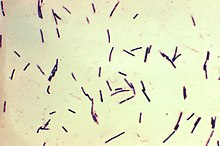Β-toxin
| Clostridium perfringens | |
|---|---|
 |
|
| Photomicrograph of Clostridium perfringens. | |
| Scientific classification | |
| Domain: | Bacteria |
| Phylum: | Firmicutes |
| Class: | Clostridia |
| Order: | Clostridiales |
| Family: | Clostridiaceae |
| Genus: | Clostridium |
| Species: | C. perfringens |
| Binomial name | |
|
Clostridium perfringens Veillon & Zuber 1898 |
|
Clostridium perfringens beta toxin is one of the four major lethal toxins produced by Clostridium perfringens Type B and Type C strains. It is a necrotizing agent and it induces hypertension by release of catecholamine. It has been shown to cause necrotic enteritis in mammals and induces necrotizing intestinal lesions in the rabbit ileal loop model.C. perfringens beta toxin is susceptible to breakdown by proteolytic enzymes, particularly trypsin. Beta toxin is therefore highly lethal to infant mammals because of trypsin inhibitors present in the colostrum.
Clostridium perfringens beta toxin shows significant genetic homology with several other toxins. C. perfringens beta toxin shows 28% homology with S. aureus alpha toxin and similar homology to S. aureus gamma-toxin and leukocidin. It appears in two forms. The smaller, with a molecular mass of 34 kDa, represents the monomeric gene product. The larger has a molecular mass of 118 kDa and may be an oligomer of smaller units. The first 27 amino acids may encode a signal that allows beta toxin to cross the cell membrane, further evidenced by the presence of beta toxin in extracellular fluid of C. perfringens cultures.
Because C. perfringens beta toxin shares homology with S. aureus pore-forming alpha toxin, it was hypothesized that beta toxin acts in a similar way. Upon investigation, it was found that C. perfringens beta toxin forms cation-selective pores in cell membranes of 1.6–1.8 nm and results in swelling and lysis in HL60 cells. Treatment of these cells with beta toxin induces and efflux K+ and influxes of Ca2+, Cl− and Na+. Heat-stable beta-toxin oligomers are shown to bind to cell membranes of human umbilical vein endothelial cells; endothelial cells are beta toxin's primary target, upon introduction. Further work on beta toxin has been hampered by its ineffectiveness on many readily available cell lines.
...
Wikipedia
